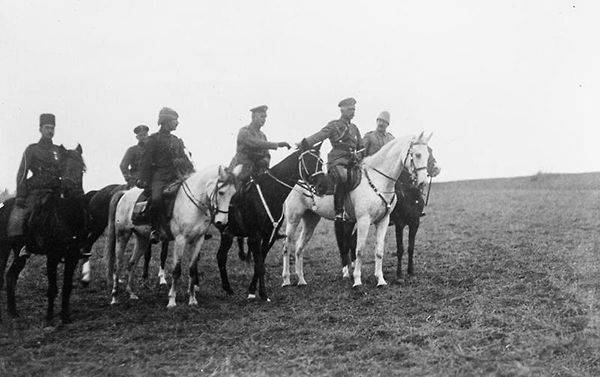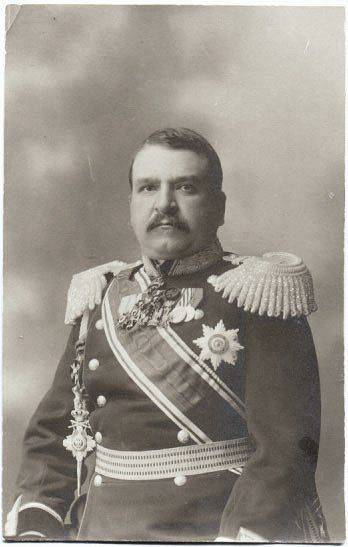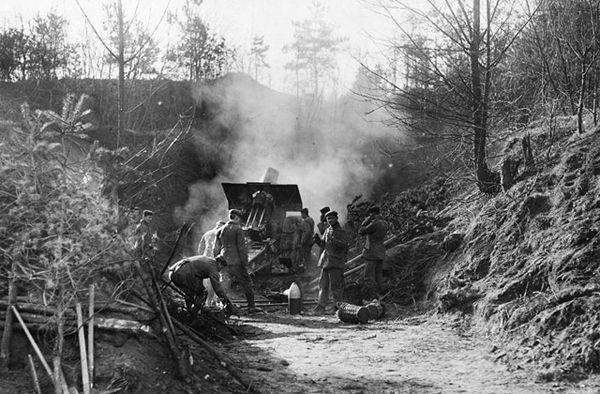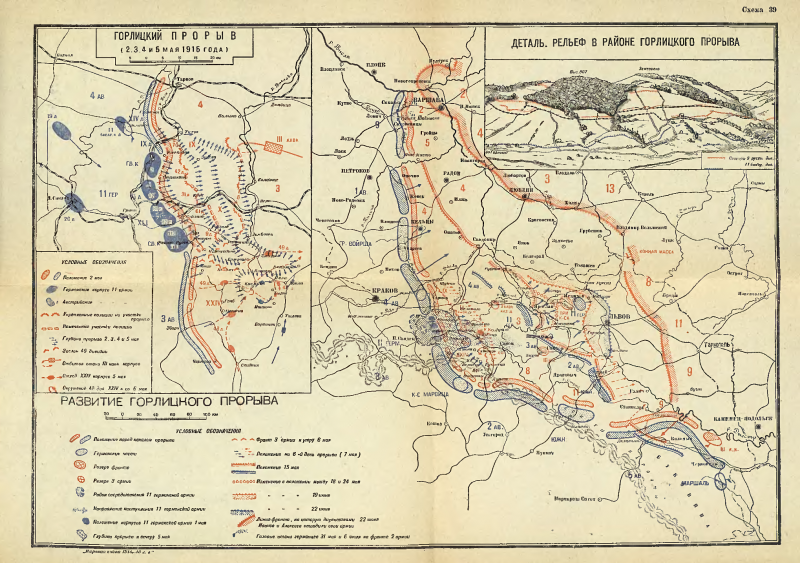Gorlitsky breakthrough
At the turn of the spring and summer periods of the 1915 campaign, the picture of the strategic position of the parties was finally determined. Berlin and Vienna firmly decided to limit their defense in the West and advance in the East, preparing a major offensive in Galicia. The Western allies of Russia, taking advantage of the moment, were building up their human and military-material base, conducting tactical operations to improve their positions on the front and trying to withdraw Turkey from the war (the Dardanelles operation). The calculation was deliberately placed on Russia, which was rich in human resources ("cannon fodder") and could pull off the best forces of the Austro-Hungarian and German empires.
In March, 1915, Russia was tied up with an agreement on the Bosphorus and Dardanelles straits, Constantinople, promising them to the Russians, in case of a victorious conclusion of the war. Imperial Petersburg undertook to wage "war to the bitter end," having lost the last opportunity to conclude a separate agreement with Germany and avoid collapse.
The tense struggle on the Eastern Front was supposed to involve Italy and Romania in the war, who believed that the time had come to take part in the division of the bear's skin. This strengthened the benefits of the strategic position of France and England, drawing the powers of the Central Powers away from them. The Russian high command continued to try to break through the Carpathian border, although it began to understand the danger of the situation. However, tormenting between the temptation to break through to Hungary and the danger of breaking through the stretched front, the Russian command could not decide to completely abandon the offensive actions and quickly undertake the regrouping of forces and the concentration of all resources and reserves to prevent the breakthrough of their front.
For the German High Command, the need to support the Austro-Hungarian Empire came first. The Austro-Hungarian army during the fierce battles with Russian troops in the campaign 1914. and in the winter - in the spring of 1915. was greatly weakened and lost the ability to independently restrain the Russians. Austrian troops could not organize a major offensive operation, even with significant support from the German troops. German forces were interspersed throughout the Austrian front, creating a kind of power corset supporting the Hapsburg empire. At p. Nida, between the Pilica and Upper Vistula rivers, the 1 Austrian army was reinforced by the German Voirsch group. Between the Upper Vistula and the foot of the Carpathians in the Myslenitsa region, at the gates to Silesia, the German division of Besser was advanced to the location of the 4 of the Austrian army. In the Beskids, the weak front of the 3 of the Austrian army was reinforced by the strong German corps (or rather, the army) Marvits. Through the wooded Carpathians east of Munkach, the German Southern Army of Linsingen advanced. In Bukovina, the German cavalry Marshall opposed a large cavalry group of the Russian 9-th army. However, this was not enough.
The Austrian high command wanted to solve this problem by requesting a larger number of German corps and divisions, retaining the leadership on the Austrian front. Konrad von Höttsendorf asked to send more German divisions to the 4 for reinforcement. However, the German command was inclined to think about the need to break through the Russian front by the Austro-German ram under the independent leadership of the German general. They chose between two sites: between Pilitsa and the Upper Vistula, or between the Upper Vistula and the foot of the Carpathian Mountains. The head of the German General Staff Erich von Falkenhayn chose the second. This area allowed the most dense concentration of troops and was better provided with flank coverage. For the development of further breakthroughs in Western Galicia, there were a number of natural obstacles here - the river Visloka, Vislok and San, but they were more passable than the Vistula. In addition, the breakthrough between the Upper Vistula and the Carpathians was dictated by the protruding position of the Russian front on the Gorlitz-Tarnuv line (Tarnov). The German strike was directed at the most extreme outgoing angle and made the position of the Russian troops that had been drawn into the Carpathians dangerous.
The German High Command prepared a plan of operation in complete secrecy. Only 13 on April, when the German divisions were ready to land at the stations and the trains with ammunition moved into Austrian Galicia, Falkenhayn first informed the Austro-Hungarian command about the general plan of the operation. On the same day, the Austrian command agreed and began negotiations on the interaction of forces.
The situation before the battle. The ratio of forces
The Russian South-Western Front was greatly stretched: from the r. Pilitsa on the left bank of the Vistula River, further up the Dunajec River and along its tributary the r. Byala to Gribov, in the Eastern Carpathians, in the Wooded Carpathians; south of the Tysmenitsy front crossed the river. The Dniester and went down the right bank of the river, resting against the city of Chernivtsi in the border of Romania. On the right flank there was the Evert 4 Army, standing on the left bank of the Vistula. Further south, the 3-I army of Radko-Dmitriev was located - from the confluence of the r. Dunajec in the Vistula to the Lupkovsky pass through the Eastern Carpathians. To it from the south adjoined 8 army Brusilov. The left flank of the South-Western Front was the 9-th army of Lechitsky and the newly formed instead of the siege army of Przemysl small, from the 2 corps, the 11-th army of Shcherbachev, included between the 8-th and 9-th armies in the important operational direction Munkach-Stry.
The Russian commanders had already lost hope of a quick success in the Carpathian operation, but did not decide to stop it in order to regroup their forces and create a solid defense because of the danger of the Austro-German offensive. Bid saw that the armies of the South-Western Front, commanded by General Nikolai Ivanov, were stretched for 600 km, and had information about the enemy’s impending attack, but left them without special attention. Therefore, the 8 and part of the forces of the 3 army continued their offensive operations. As a result, all countermeasures were limited to the transfer of one III Caucasian corps to the Khirov front reserve. Moreover, this corps was to take part in the continuation of the Carpathian operation, which the commander of the Southwestern Front Ivanov intended to continue in late April.
Thus, neither the commander-in-chief or the commander-in-chief of the South-Western Front did not react as necessary to information received from various sources about the preparation of the Austro-German offensive in Galicia. One 3 Caucasian Corps in reserve was clearly not enough.
In contrast to the Russian command, the German command developed violent activity, preparing a powerful blow. The best troops, the most experienced commanders, who mastered new methods of battle on the Western Front, were selected to organize a breakthrough of the Russian Front. The troops were well equipped with artillery to the largest calibers, mortars, and a large number of shells. Strict secrecy measures have been taken. The trains headed to the unloading stations in a circular way. No one knew about his task before the landing station. The post office set the most stringent controls. Reconnaissance was intensely conducted at the breakthrough site; German officers studied the cutting edge. The German command organized a number of auxiliary operations to divert the attention of the enemy from the direction of the main attack. The German attack in the west at Ypres, using gas for the first time, was one such demonstration to hide the preparations for the Gorlitsky breakthrough. Hindenburg organized an auxiliary operation in the Riga-Shavel region. With the support of fleet the Germans occupied Libau.
The main ram was the new 11-I army under the command of General August von Mackensen. The 11 Army had 5 corps, total 8 German, 2 Austro-Hungarian Infantry Divisions and 1 Austrian Cavalry Division. The 11 Army had the best German troops that became famous on the Western Front: Guards Corps, X Army, XLI Reserve and Consolidated Corps, as well as the 6 Austrian Corps. The main strike force also included the 4 of the Austro-Hungarian army of Archduke Joseph Ferdinand as part of the Austrian Austrian Infantry 5, German Infantry 1 Divisions and Austrian Cavalry 1 Division. This army was also subordinated to Mackensen.
At the first stage of the attack, the Mackensen strike group was to break through the Russian front in the Gorlitz-Gromnik sector, knock down Russian troops on the entire front of their 3 army from the mouth of the r. Dunajec to Lupkovsky pass. The right wing of the 11 of the German army was given the task of keeping to the main line on Zmigrod - Dukla - Sanok. At the second stage of the operation, the Austro-German troops were to encircle and destroy the 3 Russian army and develop the offensive on Peremyshl and Lviv, leaving behind the rear of other Russian armies.
At the end of April, the 11 of the German army arrived at the front of the 4 of the Austrian army, with the Austro-Hungarian army pulling to the left on the river. Dunajec, so that the 11-th army could be between the 4-th and 3-th Austrian armies. 3-I of the Austrian army of General Boroevich received the task, advancing to the left, to provide the right flank of the 11 of the German army. The left flank of the Mackensen grouping was covered by General Voirsch's group. The other armies of the Austrian front, stationed to the south of the 3, namely: the 2 of the Austrian and South, were to bind Russian troops against them with vigorous actions.
Mackensen's grouping had a great advantage: it had more than 357 thousand bayonets and sabers, 1272 light and 334 heavy guns, 660 machine guns and 96 mortars. The Germans delivered more than 1 million shells. The Germans had an especially great advantage on the 35 kilometer breakout sector: 10 infantry and 1 cavalry divisions (126 thousand people, 457 light and 159 heavy guns, 96 mortars and 260 machine guns). All 5 corps of the 11 Army participated in the breakthrough, of which 1 was placed in the second line as a reserve.
The 3-I Russian army under the command of Radko-Dmitriev stood in the way of the strike of the Austro-German group. General Radko-Dmitriev was chief of the Bulgarian General Staff, commanded the Bulgarian army during the first Balkan war, and during the second Balkan war served as an assistant to the commander-in-chief of the active army. C 1914, was the Bulgarian envoy in St. Petersburg. With the beginning of the war Radko-Dmitriev, who adhered to the pro-Russian orientation, entered the service in the Russian army. First he commanded the 8 Army Corps, then the 3 Army.
The 3 Army had about 219 thousand soldiers, 675 light and 4 heavy guns, 600 machine guns. However, from above 18 infantry and 6 cavalry divisions in the direction of the breakthrough there were only 5 infantry divisions (60 thousand people, 141 light and 4 heavy guns, 100 machine guns). Thus, in the direction of the main attack, Russian troops were inferior to enemy forces in manpower by 2 times, by artillery by 5 times (by heavy weapons - by 40 times), by machine guns - by 2,5 times.
In addition, the Russian army had a large shortage of personnel, there were not enough shells and cartridges, the 3 Army used up ammunition in past battles, Russian artillery could spend no more than ten shots on the battery per day, 25 cartridges were on one rifle. For comparison, the Germans had the opportunity to release up to 700 shots from each light and up to 250 shots from each heavy weapon within a few hours of artillery preparation. Also, the Germans for the first time used powerful mortars, which fired mines, which initially made a tremendous impression on the Russian troops with their clatter of a gap and the height of earthen fountains.
The depth of the Russian defensive orders (5 — 10 km) was insufficient, and the engineering equipment of the defensive positions was weak. Only 3 trenches were built at a distance of 2-5 kilometers from each other. There were few dugouts, there were no long-term concrete structures at all, full-fledged wire obstacles were only in front of the first line, before the second - only in places. The position of the army suffered from a lack of depth, the lines of the trenches were poorly connected with each other, had few communication lines, had no serious strongholds. The army did not have independent rear positions to which it was possible to safely withdraw with the loss of advanced fortifications. The well-suited frontiers of prek Vysloka and Vislok were not strengthened.
The soldiers occupied these positions in the X army and left flank of the XI army corps (4 total infantry divisions). In the army reserve 3 of the Russian army was 63-I infantry division near the town of Jaslo, where the army headquarters was located. In addition, cavalry and Cossacks were stationed in the rear for recreation.
Preparation for the strike found. Since 25 April, Radko-Dmitriev has sent alarming reports to the front headquarters. But he already earned a reputation as a “scared crow”. Constantly considered the position of his army especially difficult, he asked for reinforcements. However, this time he was supported by the commander of the 8 Army, Brusilov, who reported on the accumulation of enemy forces. But the commander-in-chief of the front, Ivanov and his chief of staff, Dragomirov, believed that the Germans always attack on the flanks, therefore the most likely part of the enemy’s offensive is the south, the line of the 9 Army. It was there that the Southern Army of Lizingen tried to break through last time. And they are preparing an auxiliary, distracting blow against the 3 Army, they want to deceive. Therefore, the front command did not take any measures. Even Radko-Dmitriev himself, although he received information about the threat looming over the army, did not take measures to strengthen the defense, did not tighten up the battle formations, did not start evacuating logistical institutions.

August von Mackensen (second right on a white horse)

3 Army Commander Radko-Dmitriev
The beginning of the battle
The attack on Mackensen's troops was launched on 2 on May 10 am. It was preceded by a strong artillery preparation of 600 guns, which opened fire on 1 in May from 9 hours of the evening with interruptions. During breaks, the sappers prepared the passages in the barriers. Immediate preparation, when all the guns had the highest rate of fire, began at 6 in the morning on May 2 and lasted until the 9 hour. After that, mortars opened fire to destroy trenches and wire obstacles. In a short period of time, the Russian trenches were destroyed, and the rags remained from the wire barriers.
In 10 hours the Germans moved the fire into the depths. The attack went German infantry. On the first day, the German soldiers were given a rather modest task - to take the first line of trenches. The German army performed it entirely, repulsed two counterattacks on its right flank and in the center, and advanced into the depth of the Russians only in 2-5 km. Germans captured 17 thousand people captured and 8 guns.
However, the next day, the German troops met with unexpectedly strong resistance, although an 35-kilometer front was launched to 5 shells for every meter. Russians stood to death. Machine guns mowed down enemy chains. Germans and Austrians lay down. They had to repel violent counterattacks of Russian troops. The unstoppable breakthrough did not happen, we had to organize the second and third artillery preparation. The German artillery was already leading not solid fire, but concentrated the attack on machine-gun points, separate resistance centers. May 3 Mackensen was forced to throw into battle the reserve X German corps. But despite this, Mackensen's troops were unable to complete the task set for that day - to seize the third line of trenches. The Germans took only the second line of trenches and advanced 2-6 kilometers in a day.
Thus, in the first 2 days, the Austro-German attacks were reduced to the frontal displacement of the Russian troops, and in their attack there was not yet anything especially threatening for the South-Western Front or the 3 of the Russian army. The Germans had a significant numerical advantage and delivered powerful artillery strikes. But the courageous Russian troops (42-I division of the IX corps, 31-I, 61-I and 9-I divisions of the X corps and the right flank of the 49-th division of the XXIV corps) held a punch. The Russian soldiers completed the task, won time for the front command and the army to understand the degree of threat and take appropriate countermeasures. By this time, Mackensen had already thrown all his corps into battle, and the 3-th Caucasian corps was approaching the Russian troops. The Russian command was to delay the left flank of the 3 army of Radko-Dmitriev and the right flank of Brusilov's 8 army, and also form the necessary reserves. The further attack of the 11 of the German army by Mackensen threatened the withdrawal of the XXIV army corps.

German 210 howitzer firing at Russian positions
To be continued ...

Information